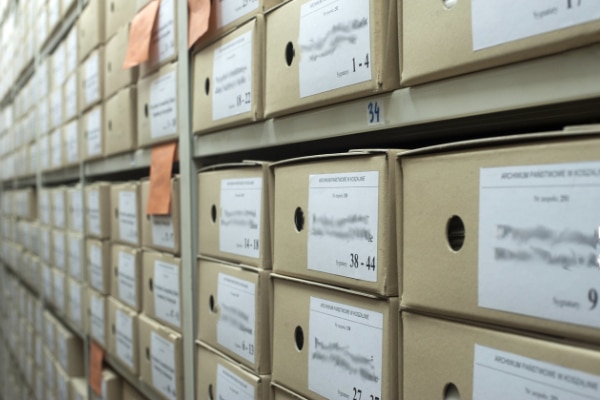
Do you have pictures of yourself when you were a child? Did you keep your high school diploma? Of course, you did. You want to be able to look back on your life’s accomplishments and share your history with your children and grandchildren. But what about your business? You kept your previous years’ tax documents, but what about photos from your first presentation or the certificate for volunteering at a local non-profit? It’s time to build your business archive.
What is a Business Archive?
Your business archives comprise selected records and other items that chronicle your company’s operational, cultural, and social history. Your business keeps records of its activities to meet financial, legal, and industry requirements. Most records fall into one of three broad categories:
- Vital Records: Documents that enable the business to continue should a disaster occur, including ownership, legal status, copyrights, patents, etc.
- Administrative Records: Documents, spreadsheets, emails, etc., that capture routine activities such as human resources, finance, equipment and supplies, and general correspondence.
- Operational Records: Describe the core functions of your business and show how it has changed over time. They detail activities, decisions, obligations, and responsibilities, including policies and procedures, records of assets, legal agreements, etc.
Why Create a Business Archive?
Just as your family photos and memorabilia document personal history, your business records are your company’s memorabilia. Your business archive explains:
- how and why your business started
- its corporate structure and how it has changed over time
- the creation and development of products and services offered
- when different policies and procedures were implemented and changed
- interactions with media, other businesses, and the community
Like your childhood School Days Scrapbook, your business archives can be a great trip down memory lane, reminding you of your success. But it is so much more than that! Archival records are used for:
- Strategic Planning. By reviewing past plans and their outcomes, the company can make better decisions in the future.
- Trend Analysis. Analyzing financial data over multiple years can help the company better predict when to expand or when to stay the course.
- Legal Purposes: Archiving past marketing collateral and publications can help protect the company from trademark infringement and legal and intellectual property threats.
- Transitions: Knowledge about the company’s brand history ensures the brand’s integrity going forward regardless of who owns or is employed at the company.
What Records are Kept in an Archive?
When you don’t know what to keep in your business archives, it can be tempting to keep everything – just in case. Which documents you retain will depend on the way your industry and the way you manage your business. Take the time to consider what you need to keep and why. Then, create a clear policy. You may already have many of these records stored all over the place. A clear, well-defined policy will help you sort and organize your information more effectively and efficiently.
Archival Storage
Physical Items
How you store physical items will depend on what those items are. I’ve provided some suggestions below.
- Photographs: Store photos in archival boxes with a card for each image describing details. Consider scanning the pictures to ensure you have a copy in case the physical ones become damaged.
- Paper: When stored carefully, paper (newspaper, magazines) can last quite a while. However, it is worth creating and saving a high-quality digital copy.
- Other Items: Carr Mclean sells archival-quality garment bags, paper mending tape, archival pens, storage boxes, suit hangers, and much more to protect your items.
I also recommend that you photograph your physical items before placing them in storage. It is easier to pull up a picture on your computer than to go to the storage area and unpack and repack your carefully saved items. Photographs can also help you manage your archive inventory and serve as proof of ownership and condition should you ever need to make an insurance claim.
Digital Items
- Save your files in a format that cannot be edited, such as PDF/A, the ISO 19005 standard.
- Save original (unedited) digital photographs (preferably in TIFF format). Include details of the picture in the image meta-data (who is in it, the occasion, the photographer’s name, etc.). Or create a text file with the same name as the photo with that information.
- Use logical file names and folder structure to easily find what you need when you need it without opening each file.
- Always have at least two backup copies of your business archives. Store one in a secure vault and the other in the cloud.
- Save your website database backups and your digital marketing collateral (newsletters, landing pages, etc.) regularly (e.g., quarterly) and before and after any significant changes.
- Use the Internet Archive to store copies of your website’s pages and the pages of any other websites where you have received media coverage. The Internet Archive won’t save videos embedded within a website, so you need to capture the video with other software.
- Download your data from social media sites regularly and make sure you can access it before saving it to your archives.
Remember that your archives may contain confidential or proprietary information, so you should control access to both physical and digital records. Store your digital records on an encrypted hard drive, not a company network drive. Keep the hard drive and any physical items under lock and key.
Read more of our advice on information management. For an office organizing consultation, contact Out of Chaos through our website.
Image by Andrzej Rembowski on Pixabay.
